Evaluating Biosolarization, Cover Cropping and Strip Tillage as an Integrated Pest Management Tool in Eggplant
Dwayne Joseph - UME Educator, Kent County, Alan Leslie - UME Educator, Charles County, Kurt Vollmer - UME Specialist-Weed Management, Cerruti Hooks - Professor Department of Entomology, UMD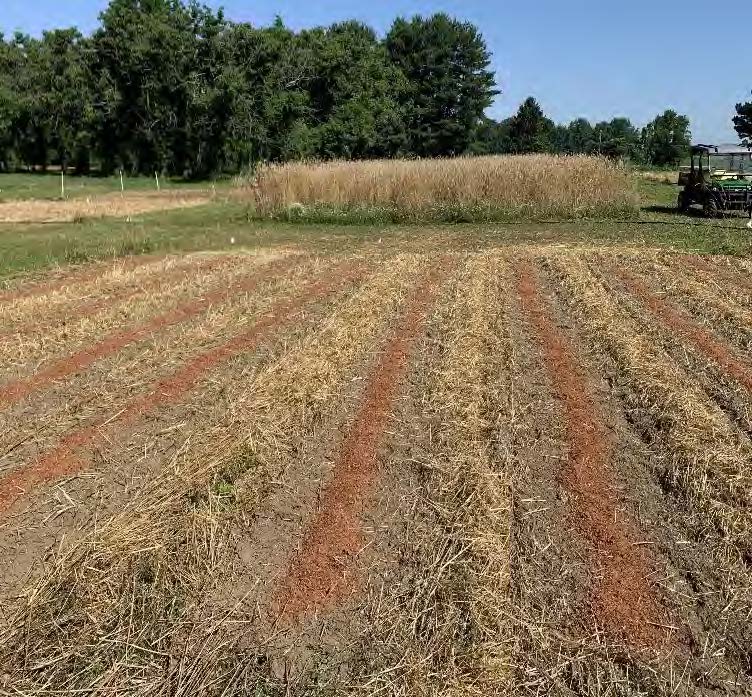
An integrated weed management approach is imperative in vegetable production. Fewer herbicides are registered in vegetables compared to row crops. Furthermore, many herbicides don’t offer full-season weed control and producers are at an increased risk of crop injury if not applied as labelled. Organic farmers consistently list weeds as a top production constraint as they invest great amounts of time and labor to manual and mechanical weed control. Our research has shown the utilization of a living mulch and strip-tillage increases weed control between rows however, the soil disturbance may lead to a weed flush within the cultivated row. To this end, biosolarization may provide an effective solution to control weeds within the strip-tilled row. Biosolarization is a soil disinfection technique similar to solarization but involves the addition of organic amendments to the soil prior to it being covered with transparent plastic tarp. The tarp facilitates the passive solar heating of the moist, amended soil, promoting the release of allelochemicals and other organic acids into the soil via increased microbial activity. The biosolarization process is performed for about ten days then the tarp is removed and the soil is allowed to aerate for about seven days prior to crop transplant.
Research has shown that biosolarization can increase weed seed mortality and decrease soil pathogens. Moreover, biosolarization is compatible with organic farming practices and can be used in suboptimal climates where solarization wouldn’t be effective. For example, to achieve optimum results from solarization, soils must reach a daily maximum temperature of above 110°F, and the plastic tarp must remain in place for at least four to six weeks. Contrarily, biosolarization utilizes organic soil amendments to decrease soil treatment time by increasing heat accumulation in the soil, thereby producing chemical factors that inactivate soil-borne pathogens and weed seed.
Fruit processing by-products (pomace) are promising soil amendments for biosolarization because they are rich in organic compounds, don’t pose any biohazard safety risks, and can be relatively abundant and inexpensive (Figure 1). In this study, the biosolarization potential of a combination of apple and grape pomace combined with a living mulch was investigated as an integrated pest management technique. We hypothesized that the fermentative by-products released during biosolarization will reduce the establishment, growth and/or survival of plant parasitic nematodes and weeds. Furthermore, the study objectives were to demonstrate the use of biosolarization, conservation-tillage and cover cropping to: 1) reduce nematode, weed and insect pests, 2) enhance crop growth and marketable yield, and 3) improve soil quality and health.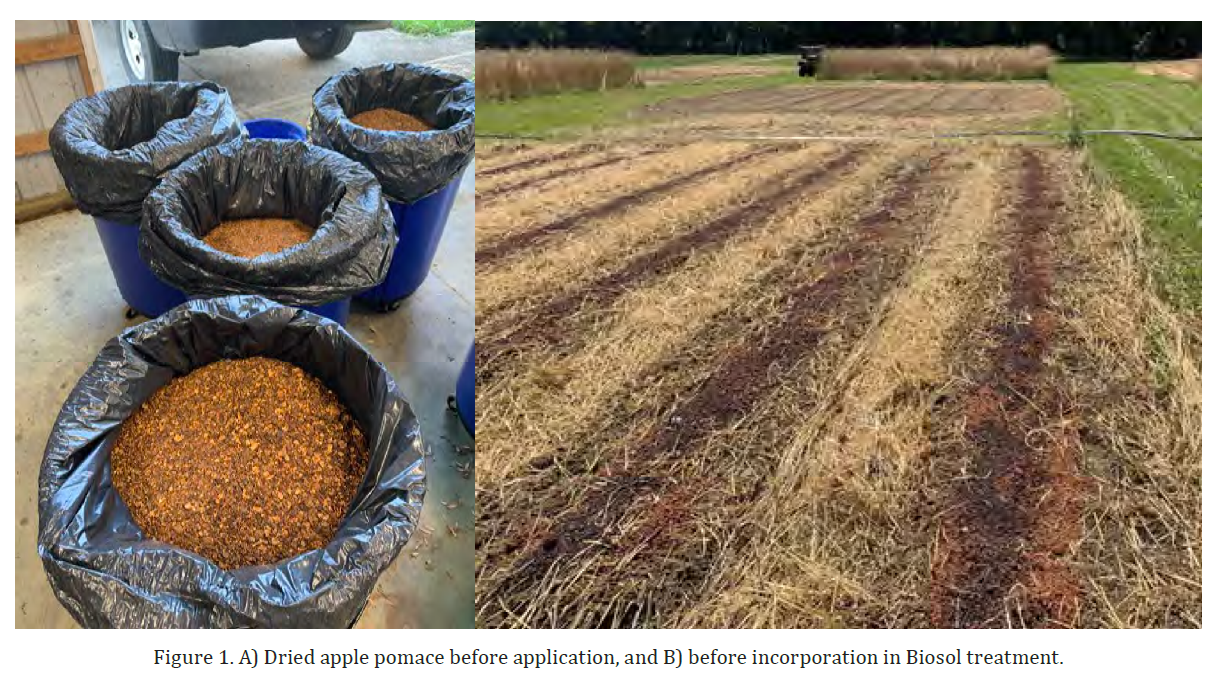
Methods
Study layout. Treatments were arranged in a randomized complete block split-plot design and were replicated four times. Whole plot treatments included eggplant: 1) grown on living mulch + no-till (LM-NT), 2) interplanted with cover crops (LM), 3) grown in solarized soil (Sol), or 4) interplanted with a cover crop and grown in biosolarized soil (Biosol). To evaluate the direct impact of whole plot treatments on eggplant growth and yield in the absent of weeds, three 5 ft × 8 ft subplot treatments were established in each plot. Weed management (hand-weeding) in these subplots included: weed-free for the entire study (WF), weed-free until nine weeks after planting (WF-9WAP), and no weed management (weedy) for entire study (WD).
Fall plot preparation. In early fall, red clover + cereal rye mixture was planted in Biosol, Sol and LM treatment plots at 6-inch row spacing. In LM-NT plots, the red clover and cereal rye was seeded in separate, alternating rows. One row of red clover was planted at each border and internal rows were alternated between six rows of cereal rye and four rows of red clover.
Spring plot preparation. In Biosol plots, the entire plot was mowed, the within-row areas (where eggplant was transplanted) was strip rotovated 40-inch wide. The apple and grape pomace mixture (3:1) was spread onto the soil surface and incorporated (rotovated), then transparent plastic tarp and drip lines were laid in rotovated zones (Figure 2). The biosolarization process proceeded for 12 days then the plastic tarp was removed and the soil was remediated for seven days before eggplant transplant. In LM-NT plots, the cereal rye was terminated with a roller crimper. In Sol plots, the entire plot was mowed and rotovated. The transparent plastic tarp and drip lines were laid in intra-row areas. In LM plots, the entire plot was roller crimped to terminate cereal rye. The within-row areas were strip-rotovated (40-inch wide) prior to transplanting eggplant. Eggplant seedlings were transplanted into all plots on the same day with a within and between-row spacing of 4 ft and 5 ft, respectively. Organic fertilizer was applied (side-dressed) according to crop nutrient requirement throughout the season.
Data Collection. Individual weed counts (species & number) were taken at 2, 4, 6 and 9 weeks after planting (WAP) from four randomly (two within- and between-row) placed 100 in2 quadrats within each plot. At 9 WAP; data for weed biomass was taken by harvesting (clipping at soil level) weeds present within two (one within-and between-row) randomly placed quadrats. Every seven days after planting, 10 plants were randomly chosen and inspected for beneficial and herbivorous arthropods. Natural enemy and epigeal predator counts were taken at seven-day intervals. To determine the effects of treatments on soil nematode presence, soil samples were collected prior to treatment applications, at eggplant transplant, and at first and final fruit harvest. Eggplant yield data was recorded from plants within the three internal rows in each plot, and all plants in each subplot. Harvested eggplant was characterized as marketable or un-marketable conforming to USDA standards.
Results
The following results are from data that was collected and analyzed from this past season. Data involving the insect and nematode aspect of this study are yet to be finalized and are not presented. Weeds present were grouped and are presented as grass, sedge and broadleaf. Also, data from within and between crop rows are presented separately because of differences in plot preparation.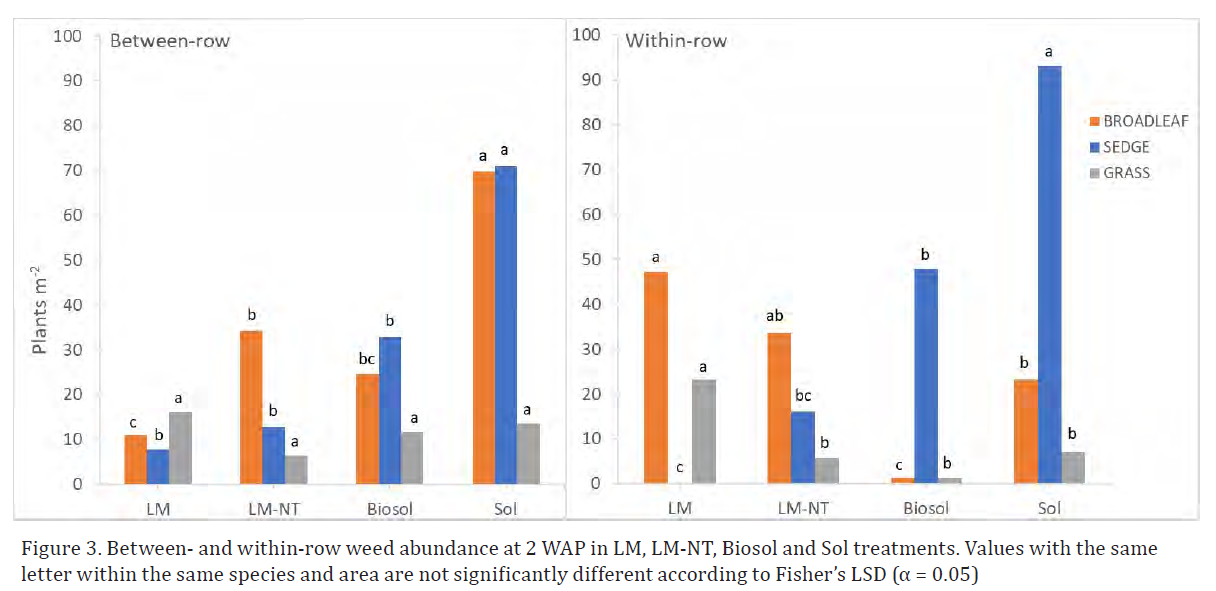
Within-row. Biosol plots had the lowest mean number of broadleaf weeds with 1.3, 1.3, 3.2 and 0 plants m-2 at 2, 4, 6 and 9 WAP, respectively; and grass weeds with 1.3, 1.3 and 7.8 plants m-2 at 2, 4 and 6 WAP, respectively. Broadleaf weeds were greatest in LM plots throughout the study (all rating times). At 2 WAP, LM plots contained significantly more broadleaf weeds than Biosol and Sol plots (Figure 3). Sedge weeds were significantly greater in Biosol and Sol plots compared to LM and LM-NT plots at all rating times. There were 94% more sedges in Sol plots than Biosol plots at 2 WAP (Figure 3). There were significantly more grass weeds in LM plots than LM-NT, Biosol and Sol plots at 2 (Figure 3) and 4 WAP (Figure 4). However, at 6 (Figure 5) and 9 WAP (Figure 6) Sol plots contained significantly 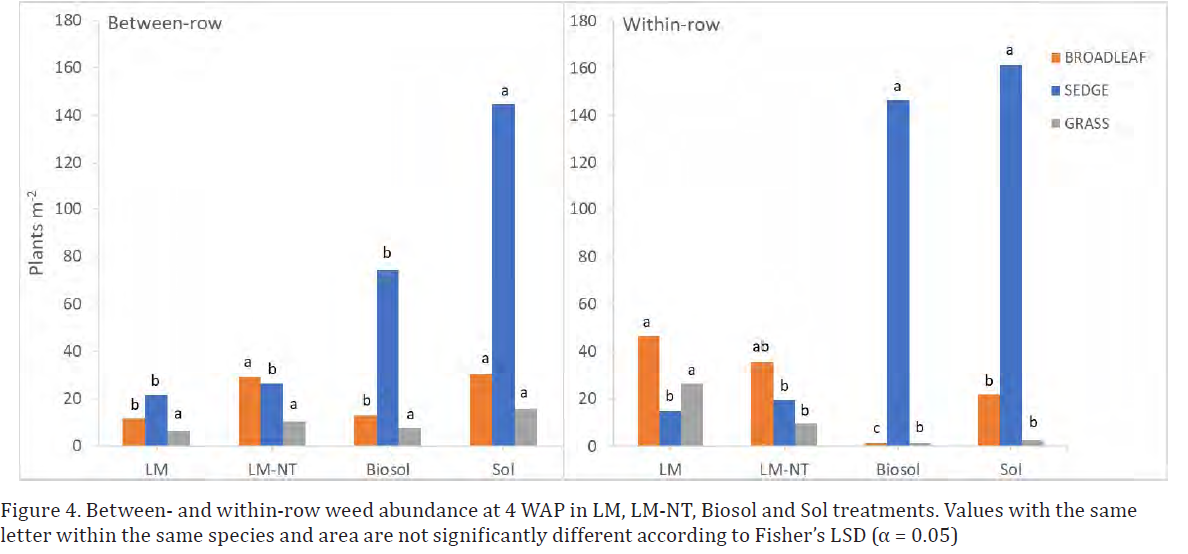
Between-row. There were significantly more sedges in Sol plots compared to the other treatments at 2 and 4 WAP. Sedges were greatest in Biosol and Sol plots at 6 and 9 WAP. LM plots contained the lowest number of sedges at all rating times compared to the other treatments. There were no significant differences in grass weeds in all treatment plots at 2 and 4 WAP however, at 6 WAP, Sol plots contained significantly more grass.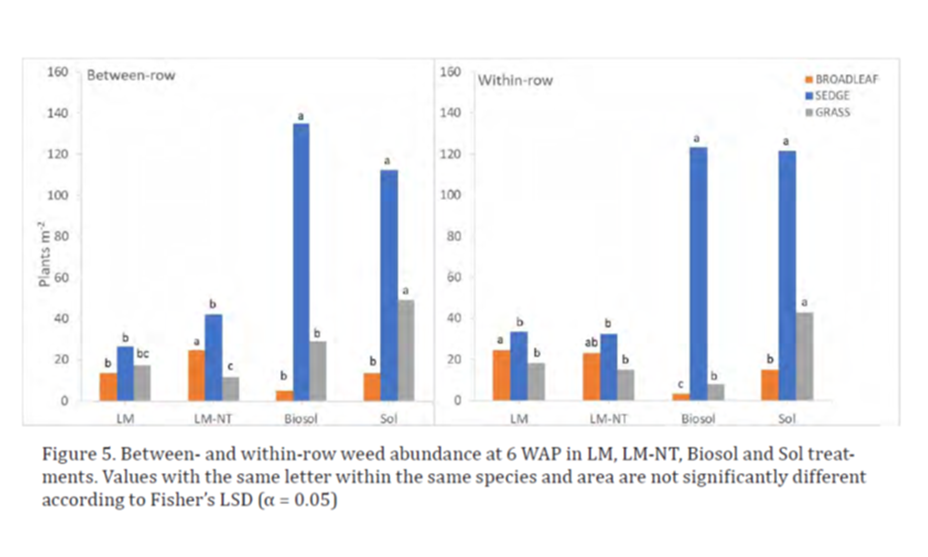

Discussion and Conclusion
Two main points can be highlighted from the within-row results: 1) the Biosol treatment was the most effective at controlling broadleaf weeds, and 2) the Biosol treatment wasn’t effective at controlling sedges. Moreover, the results show that broadleaf weed seed were effectively inactivated by biosolarization however, sedge control was minimal. This is mainly because of the two different ways in which these types of weeds reproduce and emerge. The broadleaf weeds present in the study were mainly pigweeds, carpetweed and horsenettle. These weeds are all annuals that reproduce via seed. The main sedge weed present in plots was yellow nutsedge which is a perennial that reproduces primarily from tubers that grow from creeping rhizomes. The results suggest that neither solarization nor biosolarization had a negative effect on the tubers of yellow nutsedge. Additionally, the increased tillage and heat generated by the passive solar heating process may have contributed to the emergence of yellow nutsedge. Conversely, the conservation tillage plots (LM and LM-NT) were better at yellow nutsedge suppression. This may be due to the lack of soil disturbance specifically in the no-till treatment. Also, the rye residue keeps the soil relatively cool and blocks the light stimuli that’s required for the buds on nutsedge tubers to emergence. Grass weeds present in the plots were mainly from foxtails, crabgrass and goosegrass. These grasses are all annuals that reproduce via seed, therefore biosolarization was effective at inactivating their seeds leading to early-season grass control. However, at the last rating time, the efficacy of biosolarization in managing grass weeds decreased substantially.
The high nutsedge pressure in the field contributed to the greater amount of sedge observed in all plots however, Biosol and Sol plots contained significantly more nutsedge than the conservation tillage plots at different rating times when observing the between-row areas. This may be attributed to various factors related to the spring preparation of Sol and Biosol plots. In the spring, the cover crop in Sol and Biosol plots were mowed unlike the LM-NT and LM plots. The red clover remained in those conservation tillage plots and aided in suppressing nutsedge emergence. Although the red clover between the row in Biosol plots eventually came back as the season progressed, it wasn’t enough to inhibit nutsedge emergence as was observed in conservation-till plots where the cover crop remained for the entire study.
Results of this study suggest biosolarization can be a viable option for weed management within the crop row. Furthermore, biosolarization can be an effective IWM technique in organic vegetable production. Future work may include exploring different sources of pomace, different soil amendment rates and optimizing the timing and duration of the biosolarization process.